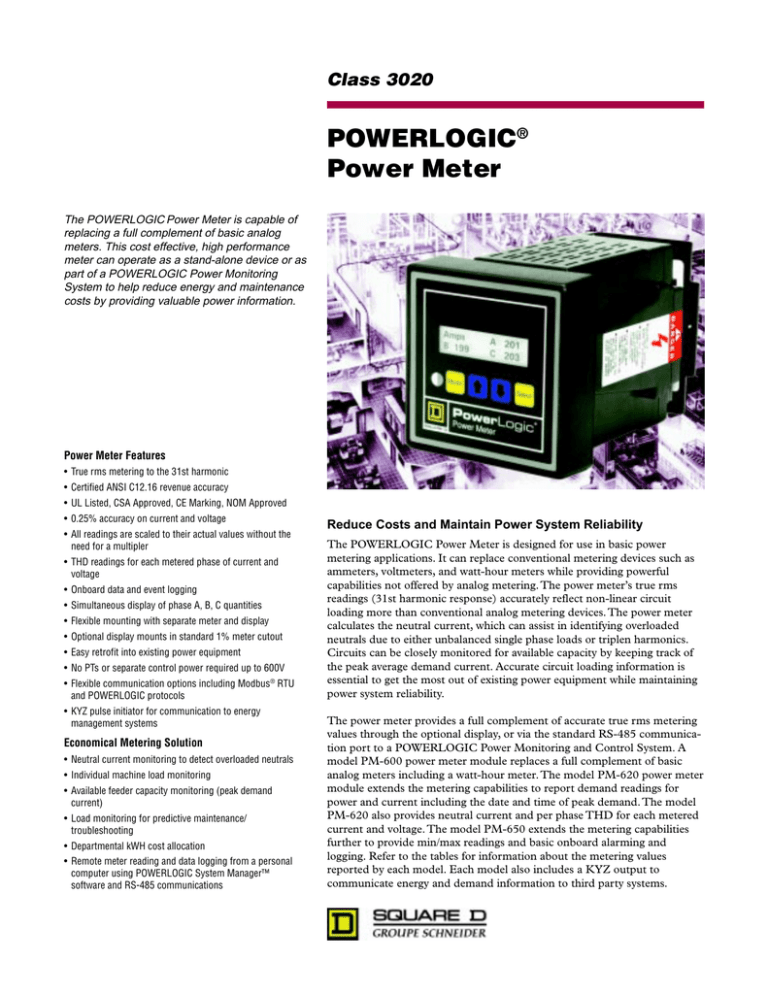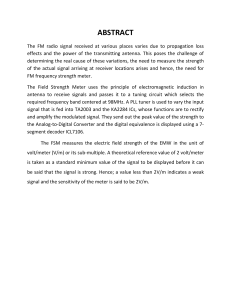
Class 3020
POWERLOGIC®
Power Meter
The POWERLOGIC Power Meter is capable of
replacing a full complement of basic analog
meters. This cost effective, high performance
meter can operate as a stand-alone device or as
part of a POWERLOGIC Power Monitoring
System to help reduce energy and maintenance
costs by providing valuable power information.
Power Meter Features
• True rms metering to the 31st harmonic
• Certified ANSI C12.16 revenue accuracy
• UL Listed, CSA Approved, CE Marking, NOM Approved
• 0.25% accuracy on current and voltage
• All readings are scaled to their actual values without the
need for a multipler
• THD readings for each metered phase of current and
voltage
• Onboard data and event logging
• Simultaneous display of phase A, B, C quantities
• Flexible mounting with separate meter and display
• Optional display mounts in standard 1% meter cutout
• Easy retrofit into existing power equipment
• No PTs or separate control power required up to 600V
• Flexible communication options including Modbus® RTU
and POWERLOGIC protocols
• KYZ pulse initiator for communication to energy
management systems
Economical Metering Solution
• Neutral current monitoring to detect overloaded neutrals
• Individual machine load monitoring
• Available feeder capacity monitoring (peak demand
current)
• Load monitoring for predictive maintenance/
troubleshooting
• Departmental kWH cost allocation
• Remote meter reading and data logging from a personal
computer using POWERLOGIC System Manager™
software and RS-485 communications
Reduce Costs and Maintain Power System Reliability
The POWERLOGIC Power Meter is designed for use in basic power
metering applications. It can replace conventional metering devices such as
ammeters, voltmeters, and watt-hour meters while providing powerful
capabilities not offered by analog metering. The power meter’s true rms
readings (31st harmonic response) accurately reflect non-linear circuit
loading more than conventional analog metering devices. The power meter
calculates the neutral current, which can assist in identifying overloaded
neutrals due to either unbalanced single phase loads or triplen harmonics.
Circuits can be closely monitored for available capacity by keeping track of
the peak average demand current. Accurate circuit loading information is
essential to get the most out of existing power equipment while maintaining
power system reliability.
The power meter provides a full complement of accurate true rms metering
values through the optional display, or via the standard RS-485 communication port to a POWERLOGIC Power Monitoring and Control System. A
model PM-600 power meter module replaces a full complement of basic
analog meters including a watt-hour meter. The model PM-620 power meter
module extends the metering capabilities to report demand readings for
power and current including the date and time of peak demand. The model
PM-620 also provides neutral current and per phase THD for each metered
current and voltage. The model PM-650 extends the metering capabilities
further to provide min/max readings and basic onboard alarming and
logging. Refer to the tables for information about the metering values
reported by each model. Each model also includes a KYZ output to
communicate energy and demand information to third party systems.
POWERLOGIC
Power Meter
Power Meter
Display
(PMD-32)
Power Meter
Module
(PM-600 or PM-620)
1
4
2
3
5
6
Power Meter Module and
Display Features
1
2
3
4
5
6
2-line x 16 character LCD display
Tactile function keys
Multi-conductor communication cable
(up to 50 feet)
Control power, metering KYZ and
communications connections
Panel or DIN rail mounting
Removable terminal shield
Mounting and Connection Flexibility
The power meter’s small size and variety of mounting configurations allow it
to be readily installed in new equipment or retrofit into existing equipment.
The power meter module can be mounted onto a 35mm DIN rail, or it can
be mounted on any flat surface using its four mounting feet. For added
simplicity in retrofit installations, the panel mounting hole patterns for both
the power meter module and the optional power meter display match the
conventional 4-inch ammeter/voltmeter spacing so the meter and the display
can be mounted back-to-back on opposite sides of a panel surface. In
metering installations of 600 V and below, the power meter provides
additional savings in both cost and mounting space by eliminating the need
for PTs and control power transformers.
The power meter accepts inputs from standard 5 A CTs and has full scale
input of 10 A. The voltage inputs can be directly connected to 3 phase
circuits of 600 V and below without the need for PTs. For higher voltage
circuits, the power meter accepts a full range of PT primary values with
control power derived from the PTs or from a separate source of ac or dc
control power.
Versatile Display
The optional power meter display mounts in the same space as a conventional 4-inch ammeter and is connected to the power meter module with a
communication cable. With the 2-line by 16-character LCD display, the user
can view metering data, and access the password protected meter setup and
resets menus. Since the power meter display can be mounted up to 50 feet
away from the power meter module, power metering can now be installed in
tight equipment spaces without sacrificing convenient and affordable local
display. The power meter display cable connects to the meter using a
standard RJ-11 connector which provides both communications and control
power to the display. If local display is not required on every meter, one
display can be used to setup any number of power meters to communicate
with POWERLOGIC application software. The communications port on the
power meter display is optically isolated from the 600 V metering connections.
Setup and resets are password protected and are easily done through the
power meter display or via the network using System Manager™ 3000
software. From the optional display, POWERLOGIC or Modbus RTU
protocols can be selected. No DIP switches or other hardware adjustments
are required for setup. All readings are scaled to their actual values without
the need for a multipler.
Advanced Functionality
In addition to the basic metering functions, the power meter increases its
value to you with advanced functionality features.
• Power Quality Readings – Total Harmonic Distortion (THD) for
current and voltage readings indicate potential power quality problems,
which unchecked, could disrupt critical processes or damage equipment.
• Min/Max Readings – Min/max readings provide measurements of
extreme meter values needed for maintenance purposes. These readings
can be viewed and reset from the display. Min/max resets are password
protected.
• Alarm/Relay Functions – The PM-650 has onboard alarms. Alarm
functions include over/under conditions for voltage, current, frequency,
and phase unbalances. In addition, these alarms can be assigned to
operate the solid-state output.
• Event Logging – When an alarm condition occurs, the PM-650 power
meter logs the event in nonvolatile memory. These events can be viewed
from the display or POWERLOGIC software.
• Data Logging – As part of a comprehensive power monitoring system,
the PM-650 expands metering capabilities with data logging. Values are
stored in nonvolatile memory, preserving critical data for the interval
between logging updates via communications with the system computer.
All metered values are available for recording at user defined intervals,
offering total flexibility. A typical log configuration is recording demand
readings for KW, kVAR, and kVA, at hourly intervals, storing 3 days of
information. The meter is pre-configured from the factory to log the
following values:
POWERLOGIC Power Meter Feature
Comparison
Meter Feature
Values
Model Model Model
PM-600 PM-620 PM-650
●
●
●
Current, per phase
A, B, C
Current, neutral
N
●
●
Volts, L-L
A-B, C-B, C-A
●
●
●
Volts, L-N
A-N, B-N, C-N
●
●
●
Real power (kW)
A, B, C, total
●
●
●
Reactive power (kVAR)
A, B, C, total
●
●
●
Apparent power (kVA)
A, B, C, total
●
●
●
Power factor (true)
A, B, C, total
●
●
●
●
●
●
Frequency
- Line-to-Line Voltages for Phases A-B, B-C, C-A
Real energy (kWh)
3 phase total
●
●
●
- True Power Factor
Reactive energy
(kVARh)
3 phase total
●
●
●
3 phase total
●
●
●
Signed, absolute,
energy in,
energy out
●
●
●
KYZ output
●
●
●
RS-485 POWERLOGIC
and Modbus RTU
communications
●
●
●
- Present Current Demand for Phases A, B, C, and neutral
- kW Demand - 3 Phase Total
- kVAR Power Demand - 3 Phase Total
- kVA Power Demand - 3 Phase Total
POWERLOGIC application software is used to customize data log
configurations.
POWERLOGIC System Compatibility
The power meter supports standard POWERLOGIC RS-485 communications up to 19,200 Baud with communications links up to 10,000 feet. A
meter can quickly be installed into any existing POWERLOGIC system. The
power meter is fully integrated into the latest POWERLOGIC application
software, System Manager 3000. SMS-3000 software enables users to
manage their electrical distribution systems by providing tabular and
graphical data displays, alarms, real time and historical time trend tables and
graphs, and reports. Power meter setup, reset operations, and wiring
diagnostics can also be performed from a remote personal computer using
System Manager 3000 software.
POWERLOGIC power monitoring devices and systems assist in equipment
monitoring for cost allocation, troubleshooting, predictive maintenance,
planning, and more. The lower installed cost of the power meter makes it
possible for facilities to monitor many smaller, less critical feeder circuits
enabling whole facility power monitoring.
Apparent energy
(kVAh)
Energy accumulation
modes
THD, voltage & current
A, B, C
●
●
Current demand
A, B, C, N,
present & peak
●
●
Real power demand
(kWd)
3 phase total,
present & peak
●
●
Reactive power
demand (kVARd)
3 phase total,
present & peak
●
●
Apparent power
demand (kVAd)
3 phase total,
present & peak
●
●
Date/time stamping
Peak demands,
power up/restart,
resets
●
●
Predicted power
demand
Onboard alarms
Min/max readings
Frequency,
current, voltage,
power, power
factor, THD
●
●
●
●
Data and event logs
Advanced demand
options
Example of a POWERLOGIC Power Monitoring and Control System
kW, kVAR, kVA
Under/over
conditions, phase
unbalance
conditions
Synch to comms,
sliding block
calculation
●
POWERLOGIC
Power Meter
Typical Wiring Diagram†
Technical Specifications
Metering Specifications
Current Inputs
Current Range ............... 0–10A ac
Nominal Current ............ 5 A ac
Overcurrent Withstand .... 500 A, 1 second
Burden ........................... 0.15 VA
Voltage Inputs
Voltage Range ................ 20–600 V ac
Nominal Voltage ............. 208/120, 480/277,
600/347 V rms
Input Impedance ............ >2 Megohms
Frequency Range
(50/60 Hz) ..................... 45–65 Hz
Accuracy
Current .......................... 0.25%‡
Voltage ........................... 0.25%‡
Power ............................. 0.50%‡
Energy ........................... 0.50%‡
Demand ......................... 0.50%‡
Power Factor .................. 1.00%
Frequency 50/60 Hz ....... 0.02 Hz
Aø
Bø
LOAD
LINE
Cø
N
VDS
TOP
8
A
9
B
C
10
11
VOLTAGE
L2 7
CONTROL
POWER
L1 6
A– B– C–
15
13 14
CURRENT
16
17
18
A+ B+ C+
COMM'S
Control Power Input Specifications
Input Range, ac ................. 90–600 V ac
Frequency Range .............. 45–65 Hz
Input Range, dc ................. 100–300 V dc
Burden ............................. 90 Vac–264 Vac 10 VA
265 Vac–600 Vac 30 VA
Temperature Specifications
Meter Module (operating) . 0 to 60°C
Meter Display (operating) .. 0 to 55°C
NOTE: CONTROL POWER CAN
BE DRAWN FROM FUSED
VOLTAGE INPUTS L-L OR
L-N OR AN EXTERNAL
SOURCE
L1–L2 100 – 300VDC
90 – 600VAC
FUSES
+IN
–IN
+OUT
–OUT
SHLD
5
4
3
2
1
N
12
KYZ
19
20
21
22
†
3-Phase, 4-Wire WYE. (3-Wire Delta and other system types supported.)
‡
For readings less than 20% nominal add ±0.05% full scale.
DISPLAY JACK
Power Meter Dimensions
6.03
153
3.81
96.7
4.50
114
4.62
117
Ordering Information
3.63
92.1
INCHES
MILLIMETERS
4.50
114
4.50
114
1.26
32.0
POWERLOGIC, Square D, and are registered
trademarks of Square D Company. System Manager is a
trademark of Square D Company. Modbus is a
registered trademark of Schneider Automation, Inc.
Bulletin No. 3020HO9601R10/98 October 1998
Class
Type
3020
PM600
Power Meter Module, Basic Instrumentation
3020
PM620
Power Meter Module, Basic Instrumentation, plus
Demand, THD, D/T Stamping, Neutral Current
3020
PM650
Power Meter Module, Min/Max, Alarms, Event and
Data Storage, plus PM-620 Features
3020
PMD32
Power Meter Display with 1 Foot Cable
3020
SC104
Optional 4 Foot Cable
3020
SC112
Optional 12 Foot Cable
3020
SC130
Optional 30 Foot Cable
Description
© 1998 Square D All Rights Reserved




